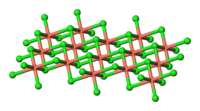
Photo from wikipedia
Synchrotron X-rays are widely used for material characterizations. However, they can also ionize atoms and molecules to damage and manipulate probed materials. We report here an X-ray-induced growth of copper… Click to show full abstract
Synchrotron X-rays are widely used for material characterizations. However, they can also ionize atoms and molecules to damage and manipulate probed materials. We report here an X-ray-induced growth of copper hydroxide nitrate, Cu2(OH)3NO3, on copper thin films in the ambient atmosphere without solvents and thermal treatment. In situ synchrotron X-ray diffraction measurements showed that the time-dependent growth process of theCu2(OH)3NO3 is accompanied by the consumption of Cu metal and can be described by a sigmoidal model. The growth rate was reduced after the initial fast growth period. Scanning electron microscopy (SEM) images show that the isolated islands of Cu2(OH)3NO3 nanoplates formed in the beginning, which grew together with new nanoplates formed under continued X-ray irradiation. The result demonstrated that high-flux synchrotron X-rays may provide an unconventional approach to synthesizing and manipulating materials, which will inspire future investigation both experimentally and theoretically.
Journal Title: ACS applied materials & interfaces
Year Published: 2022
Link to full text (if available)
Share on Social Media: Sign Up to like & get
recommendations!